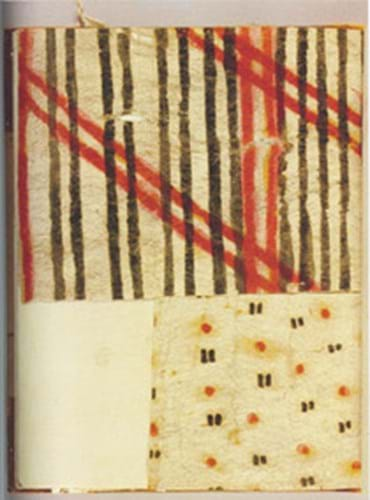
Published for Alexander Shaw in 1787, eight years after Cook's death, it deals with tapa, or bark cloth manufacture in the South Seas islands. Used principally for clothing, tapa cloth also functioned as a medium of exchange and a symbol of wealth and prestige throughout the islands.
Shaw's text was based on the observations of Mr Anderson and Reinhold Foster - the latter the expedition's naturalist - as well as verbal accounts provided by "the most knowing of the Navigators", the islanders themselves, but what makes this work truly exceptional is the fact that it was illustrated with actual specimens of cloth.
Examples collected from the islands of Tongabatu, Tahiti and the Hawaiian group are cited, but each copy is a more or less unique collection. Each specimen is briefly identified as to source and use or purpose, but in some cases an anecdote relating to its acquisition is added. Of a mulberry bark cloth worn by Tahitian chiefs, we learn:
"Some of the seamen were sent ashore to bring fresh provisions on board; and... one of them wandered a little way up the country, where he saw some children at play, which to his surprize they all left, and surrounded him, making many antic gestures; at last a girl, about fourteen years of age, made a leap at him, at the same time endeavoured to seize a few red feathers which he had stuck in his cap, which he directly took out and presented her; upon which she made off with amazing swiftness... he then returned to his companions, who were preparing to go on board. It was now the cool of the evening, when she came down to the waterside, and singling him out from the rest, presented him the piece of cloth from which this was cut. A true sign of gratitude in those people."
A beautiful lace-bark specimen acquired not in the South Seas but in Jamaica is often missing in surviving copies, but one offered at Christie's New York on June 27-28 was complete with 39 specimens as described in the printed contents list. In a contemporary English binding, it sold at $120,000 (£66,000) to an American collector.
The cataloguer noted that the three other most recent copies to have come to auction offered between 32 and 38 specimens only. In 1995 Bonhams sold one with 32 samples for £11,000 and two years ago, at Sotheby's, a copy presenting 36 reached £46,000. The near-complete copy with 38 samples to which the US catalogue refers is one that made £1100 at Sotheby's back in 1977, but what the cataloguer has omitted from this census is a copy seen at Sotheby's just a year earlier. That one, sold at £1900, must have been something very special as it apparently offered no fewer than 56 cloth samples!
By Ian McKay




